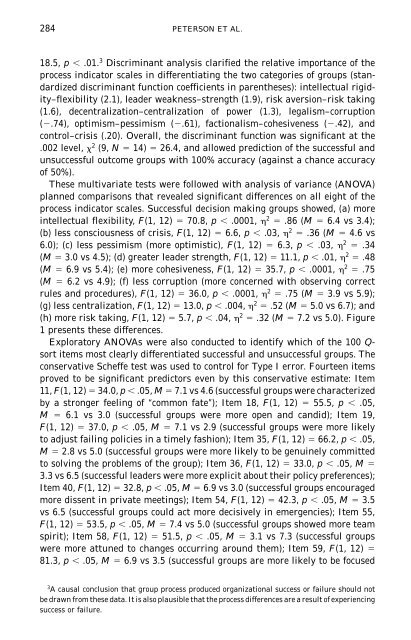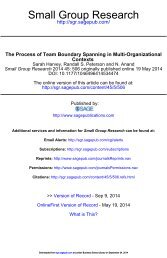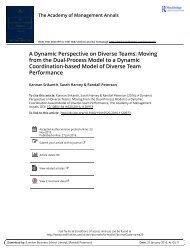Group Dynamics in Top Management Teams: Groupthink, Vigilance, and Alternative Models of Organizational Failure and Success
This study explored the heuristic value of Janis’ (1982) groupthink and vigilant decision making models as explanations of failure and success in top management team decision making using the Organizational Group Dynamics Q-sort (GDQ). Top management teams of seven Fortune 500 companies were examined at two historical junctures—one when the team was successful (defined as satisfying strategic constituencies) and one when the team was unsuccessful. Results strongly supported the notion that a group’s decision making process is systematically related to the outcomes experienced by the team. Ideal-type Q-sorts organized around Janis’ analysis of groupthink and vigilance were substantially correlated with Q-sorts of failing and successful groups, respectively. The fit was, however, far from perfect. Ideal type Q-sorts derived from other frameworks correlated better with the failure–success classification than did the Janis-derived ideal types. Successful groups showed some indicators of groupthink (e.g., risk-taking, cohesion, and strong, opinionated leaders), whereas unsuccessful groups showed signs of vigilance (e.g., internal debate to the point of factionalism). The results illustrate the usefulness of the GDQ for developing and empirically testing theory in organizational behavior from historical cases.
This study explored the heuristic value of Janis’ (1982) groupthink
and vigilant decision making models as explanations of
failure and success in top management team decision making
using the Organizational Group Dynamics Q-sort (GDQ). Top
management teams of seven Fortune 500 companies were examined
at two historical junctures—one when the team was successful
(defined as satisfying strategic constituencies) and one when the team was unsuccessful. Results strongly supported the notion
that a group’s decision making process is systematically related
to the outcomes experienced by the team. Ideal-type Q-sorts organized
around Janis’ analysis of groupthink and vigilance were
substantially correlated with Q-sorts of failing and successful
groups, respectively. The fit was, however, far from perfect. Ideal type
Q-sorts derived from other frameworks correlated better
with the failure–success classification than did the Janis-derived
ideal types. Successful groups showed some indicators of groupthink
(e.g., risk-taking, cohesion, and strong, opinionated leaders),
whereas unsuccessful groups showed signs of vigilance (e.g.,
internal debate to the point of factionalism). The results illustrate
the usefulness of the GDQ for developing and empirically testing
theory in organizational behavior from historical cases.
- No tags were found...
You also want an ePaper? Increase the reach of your titles
YUMPU automatically turns print PDFs into web optimized ePapers that Google loves.
284 PETERSON ET AL.<br />
18.5, p .01. 3 Discrim<strong>in</strong>ant analysis clarified the relative importance <strong>of</strong> the<br />
process <strong>in</strong>dicator scales <strong>in</strong> differentiat<strong>in</strong>g the two categories <strong>of</strong> groups (st<strong>and</strong>ardized<br />
discrim<strong>in</strong>ant function coefficients <strong>in</strong> parentheses): <strong>in</strong>tellectual rigidity–flexibility<br />
(2.1), leader weakness–strength (1.9), risk aversion–risk tak<strong>in</strong>g<br />
(1.6), decentralization–centralization <strong>of</strong> power (1.3), legalism–corruption<br />
(.74), optimism–pessimism (.61), factionalism–cohesiveness (.42), <strong>and</strong><br />
control–crisis (.20). Overall, the discrim<strong>in</strong>ant function was significant at the<br />
.002 level, 2 (9, N 14) 26.4, <strong>and</strong> allowed prediction <strong>of</strong> the successful <strong>and</strong><br />
unsuccessful outcome groups with 100% accuracy (aga<strong>in</strong>st a chance accuracy<br />
<strong>of</strong> 50%).<br />
These multivariate tests were followed with analysis <strong>of</strong> variance (ANOVA)<br />
planned comparisons that revealed significant differences on all eight <strong>of</strong> the<br />
process <strong>in</strong>dicator scales. <strong>Success</strong>ful decision mak<strong>in</strong>g groups showed, (a) more<br />
<strong>in</strong>tellectual flexibility, F(1, 12) 70.8, p .0001, 2 .86 (M 6.4 vs 3.4);<br />
(b) less consciousness <strong>of</strong> crisis, F(1, 12) 6.6, p .03, 2 .36 (M 4.6 vs<br />
6.0); (c) less pessimism (more optimistic), F(1, 12) 6.3, p .03, 2 .34<br />
(M 3.0 vs 4.5); (d) greater leader strength, F(1, 12) 11.1, p .01, 2 .48<br />
(M 6.9 vs 5.4); (e) more cohesiveness, F(1, 12) 35.7, p .0001, 2 .75<br />
(M 6.2 vs 4.9); (f) less corruption (more concerned with observ<strong>in</strong>g correct<br />
rules <strong>and</strong> procedures), F(1, 12) 36.0, p .0001, 2 .75 (M 3.9 vs 5.9);<br />
(g) less centralization, F(1, 12) 13.0, p .004, 2 .52 (M 5.0 vs 6.7); <strong>and</strong><br />
(h) more risk tak<strong>in</strong>g, F(1, 12) 5.7, p .04, 2 .32 (M 7.2 vs 5.0). Figure<br />
1 presents these differences.<br />
Exploratory ANOVAs were also conducted to identify which <strong>of</strong> the 100 Q-<br />
sort items most clearly differentiated successful <strong>and</strong> unsuccessful groups. The<br />
conservative Scheffé test was used to control for Type I error. Fourteen items<br />
proved to be significant predictors even by this conservative estimate: Item<br />
11, F(1, 12) 34.0, p .05, M 7.1 vs 4.6 (successful groups were characterized<br />
by a stronger feel<strong>in</strong>g <strong>of</strong> “common fate”); Item 18, F(1, 12) 55.5, p .05,<br />
M 6.1 vs 3.0 (successful groups were more open <strong>and</strong> c<strong>and</strong>id); Item 19,<br />
F(1, 12) 37.0, p .05, M 7.1 vs 2.9 (successful groups were more likely<br />
to adjust fail<strong>in</strong>g policies <strong>in</strong> a timely fashion); Item 35, F(1, 12) 66.2, p .05,<br />
M 2.8 vs 5.0 (successful groups were more likely to be genu<strong>in</strong>ely committed<br />
to solv<strong>in</strong>g the problems <strong>of</strong> the group); Item 36, F(1, 12) 33.0, p .05, M <br />
3.3 vs 6.5 (successful leaders were more explicit about their policy preferences);<br />
Item 40, F(1, 12) 32.8, p .05, M 6.9 vs 3.0 (successful groups encouraged<br />
more dissent <strong>in</strong> private meet<strong>in</strong>gs); Item 54, F(1, 12) 42.3, p .05, M 3.5<br />
vs 6.5 (successful groups could act more decisively <strong>in</strong> emergencies); Item 55,<br />
F(1, 12) 53.5, p .05, M 7.4 vs 5.0 (successful groups showed more team<br />
spirit); Item 58, F(1, 12) 51.5, p .05, M 3.1 vs 7.3 (successful groups<br />
were more attuned to changes occurr<strong>in</strong>g around them); Item 59, F(1, 12) <br />
81.3, p .05, M 6.9 vs 3.5 (successful groups are more likely to be focused<br />
3 A causal conclusion that group process produced organizational success or failure should not<br />
be drawn from these data. It is also plausible that the process differences are a result <strong>of</strong> experienc<strong>in</strong>g<br />
success or failure.

















